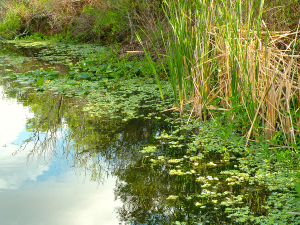Ask Bill: Can you give me some information and tips about bass fishing around cattails?
Posted: September 10th, 2014 by Bill Dance
Bill: Cattails are just like any other bass structure in that you have to understand this standing vegetation and work them carefully, thoroughly and correctly to catch bass on a consistent basis.
The cattail is a wild plant that grows in swamps and marshes throughout the United States and southern Canada. In some places, cattails cover acres of marshland with their waving, green leaves. The larger cattails grow to a height of 5-6 feet and have long, broad leaves. The smaller plants have narrow leaves. Cattail flowers become the long, brown spikes that are sometimes used as decorations. On the Pacific Coast, cattails are known as “tulle-reeds.”
 In most of the places that I fish, cattails grow in the 1-3 feet of water and floating logs. They can be found on high spots in lakes and near other forms of shallow structure and provide excellent cover for shallow-water bass.
In most of the places that I fish, cattails grow in the 1-3 feet of water and floating logs. They can be found on high spots in lakes and near other forms of shallow structure and provide excellent cover for shallow-water bass.
As good as these forms of aquatic growth are, it is important to understand that most plants use nutrients and sunlight to produce plant material and oxygen during the day. But at night, the process reverses and the plant life creates a tremendous demand on the very oxygen it produced during the day. This alone can have a major effect on how bass relate to the plants during a 24-hour period.
Over the years, I have found four noticeable times when bass move away from cattail areas: when the plants turn brown or tan and begin to decay; at night, especially after a cloudy day; during a heavy bloom, which raises pH or alkaline base; and after several cloudy, calm days.
These are the times when you will usually find bass out in front of the cattails. Normally, they will not move a great distance. And when conditions return to normal, the fish will journey back to the key features.
In this situation flipping and pitching are excellent ways to catch bass that are in a non-feeding mood. You will be able to cover a wider range. Secondly, you will be able to keep your offering in one spot for a longer period of time. And finally, if the bass are inactive, you will be in a better position to tease them into biting.
When you approach an area thick with cattails, here are a few key areas to target: dips, depressions, points, pockets and creek mouths, canal openings and deeper banks.
Approach with this in mind.
- Cattail depressions usually have deeper depressions leading to the mouth of the opening. Both sides can be productive.
- Cattail points usually closer to deeper water are usually best.
- Deeper cattail banks are very productive areas, especially around the small openings and pockets which extend out.
- Undercut cattail banks are great, but usually difficult to locate.
- Any opening in a group of cattails can produce big fish.
- Cattail lined canals can be outstanding, along both holes and at the deeper holes located at canal ends.
As always, catch one for me!

